Annals of the MBC - vol. 4 - n' I -
Mareh 1991
A RARE CAUSE OF BURN INJURY
Navarro Monzonis A., Benito Ruiz J.,
Baena Montilla P., Mena Yago A., De la Cruz Ferrera L.I.
Department of Plastic Surgery and Burn Centre, Hospital La Fe,
Valencia, Spain
SUMMARY. This paper reports a
unique cause of burns due to a very old tradition consisting of freeing a bull with a
special device tied around its horns and set alight. Bums by this cause do not cause death
but they provoke an important morbidity especially with regard to the site of the injury,
which most commonly. affects the axilla, the inner aspect of the arms and the chest.
Associated injuries, such as cuts, bone fractures and even cranioencephalic traumas, are
not rare.
Introduction
In the context of traditional festivals in our community the
showing of cattle ("brave" cows and bulls), and more specifically the "fire
bull', is a typical element with a long history.
Though its objective is entertainment it is not a risk-free celebration. Perhaps risk is
the most attractive component because of the very essence of the rite. Risk and the
attraction of a brave bull with two balls (made of cotton waste and tar) (Fig. 1) tied by
means of a specially designed device set alight on the tips of its hornsT~(Fig. 2),
running freely inside an appropriate place, are closely linked. Injuries by these causes
are not infrequent and the plastic surgeon has an active role in their treatment.
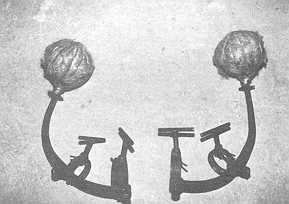 |
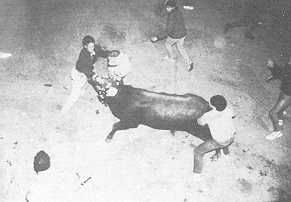 |
| Fig. I The metallic device. Observe
the ball of cotton and tar to be lighted and the screws to be tightened on the horns. |
Fig. 2 The balls are
being set alight. This is a dangerous moment for the person concerned. |
|
Results
20 patients were admitted to our Department sustaining burns from
this cause in the period 1986/89. The average age was 28.3 years (range, 13-52). 85% of
the patients were male and 15% female.
The average burn size was 19%. 30% of the patients had burns covering >30% of their
body surface. 70% of the injuries were partial thickness and deep dermal burns, and the
rest were deep dermal plus full thickness. No deaths were recorded.
The most commonly affected parts of the body were the inner aspect of the arm and the
axilla (Fig. 3), the lateral aspect of the chest (Fig. 4), and the hands. This pattern of
injury is produced when the patient is gored by the bull. Legs are burned when the victim,
trying to escape from the bull, climbs up a fence and the lighted horns come just under
him. The horns themselves do not reach the person, but the flames from the fire balls do.
Associated injuries were present in 30% of the patients. The commonest were small skin
lacerations, abrasions and contusions (70%). 6 patients had some sort of bone fractures
(especially affecting the forearm), and 3 patients had a mild cranioencephalic trauma,
with initial loss of consciousness but a successful outcome.
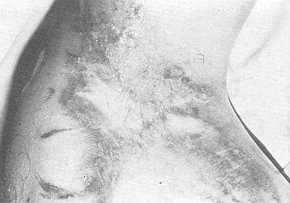 |
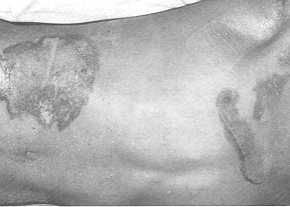 |
| Fig. 3 A typical "fire
bull" burn. The centre is full-thickness. Notice the dirtiness of the injury. |
Fig. 4 Another patient with burns
on the chest caused by a fire bull. |
|
Discussion
Burns produced by the fire bull are not very common. Most of them
are managed on an out-patient basis in First Aid Units and the rest are sent to.our
Service.
The population most frequently affected consists of young adults with a clear predominance
of men, since due to cultural reasons it is a celebration with a markedly masculine
character. Nevertheless, the small percentage of women injured indicates that they are
taking a more active role in these festivals. In addition, the usual copious intake of
alcoholic spirits increases the risk of being gored by the bull.
Burns are caused by two mechanisms:
- Direct contact with the ball in flames (the most frequent cause).
- The setting alight of the person's clothes, causing more severe, extensive burns.
As a result of the causal mechanism (violent hitting, falling to the
ground, injuries by the metal, device), there are some other associated injuries such as
cramoencephalic trauma, bone fractures, and cuts. Injuries directly caused by the horns
are extremely rare: the special design of the metal structures, longer than the horns, is
responsible for the wounds.
The most characteristic pattern of burn affects the axilla, the inner aspect of the
ipsilateral upper arm, the lateral thorax and the hands. This is due to the protective
attitude the victim takes when facing the bull (Fig. 5). Burns on the axilla may be
especially troublesome due to full-thickness burns, which may lead to contractures,
limiting the shoulder function and requiring further correcting procedures.
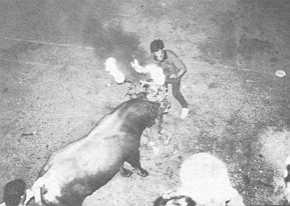 |
Fig. 5 The patient tries to protect
himself with his arms. The space between arm and chest is the site where the patient is
gored by the bull. |
|
Extensive burns are rare and they are chiefly produced by ignition of
the victim's clothes.
Prevention in this sort of "entertainmefit- is practically impossible to achieve. The
only solution would be to ban it, but, unfortunately, tradition and mistaken enjoyment far
outweigh common sense.
RÉSUMÉ. Les Autours décrivent une cause singuliére des brúlures due
á une vieille tradition qui consiste en la libération d'un taureau avec un dispositif
spécial lié aux comes et allumé. Ces brúlures ne provoquent pas la mort mais elles
causent une morbidité importante, particuliérement pour ce qui concerne le site de la
brúlure, c'est-á-dire principalement l'aisselle, l'aspect intérieur des bras et le
thorax. Les blessures associées, comme par exemple les coupures, les fractures des os et
méme les traumatismes cranioencéphaliques, ne sont pas rares.
|




